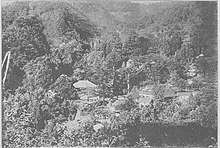Nisseki-ji
Nisseki-ji (日石寺) is a Buddhist temple in the town of Kamiichi, Toyama Prefecture, Japan. The temple belongs to the Shingon-school of Japanese Buddhism. It is more popularly known by the name of Ōiwa Fudō (大岩不動) after its main image.
| Nisseki-ji | |
|---|---|
日石寺 | |
 Nisseki-ji in 1909 | |
| Religion | |
| Affiliation | Buddhist |
| Deity | Fudō Myō-ō |
| Rite | Shingon |
| Status | functional |
| Location | |
| Location | Kamiichi, Toyama |
| Country | Japan |
 Shown within Toyama Prefecture  Nisseki-ji (Japan) | |
| Geographic coordinates | 36°39′44″N 137°23′28″E |
| Architecture | |
| Founder | Gyōki |
| Completed | 725 |
| Website | |
| Official website | |
History
The temple claims to have been founded in 725 AD by the wandering priest/miracle-worker Gyōki, who carved a 2.8 meter statue of Fudō Myō-ō in bas-relief on a cliff-face. While there are no historical records to back up this claim, the carving itself dates from the Nara period and is a designated Important Cultural Property of Japan. The statue is part of a group, which includes two of Fudō Myō-ō's assistants, a seated statue of Amida Nyorai and a seated Buddhist priest. The statues are in good preservation as they have been covered by a building for most of history. The Fudō-dō was destroyed by a windstorm in 1335, by a fire set by troops of the Uesugi clan during the late Muromachi period and again by a free in 1967.
In 1930, the carvings were designated a National Historic Site of Japan in 1934.[1]
References
- "大岩日石寺石仏". Cultural Heritage Online (in Japanese). Agency for Cultural Affairs. Retrieved 25 December 2017.(in Japanese)
External links
- Kamiichi town official site (in Japanese)
- Toyama tourist information (in Japanese)